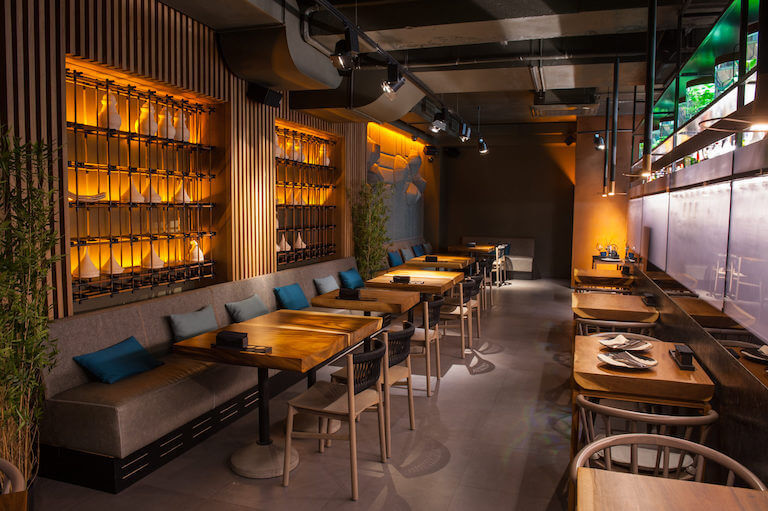Savor Authentic Oriental Food With a Pan-Asian Twist for a Culinary Journey
Embarking on a cooking trip through authentic Oriental food, boosted with a Pan-Asian twist, offers a distinct chance to check out the abundant tapestry of tastes that specify the area's varied culinary traditions. As you ponder these tempting meals, think about the cultural stories and historic influences that form them, each bite supplying a tale waiting to be discovered. pan asian restaurant Islamabad.

Discovering Pan-Asian Tastes
In the world of international gastronomy, Pan-Asian food attracts attention for its impressive diversity and the harmonious interaction of tastes from numerous Eastern cultures. This cooking approach celebrates the rich customs and one-of-a-kind components discovered throughout the continent, developing a tapestry of tastes that is both fascinating and satisfying. Trick to Pan-Asian food is its ability to stabilize different tastes-- pleasant, salted, spicy, and sour-- while highlighting the quality and quality of each component.
From the umami-rich soy sauce of Japan to the fiery chili peppers of Thailand, Pan-Asian cuisine supplies a considerable palette of tastes. These elements are typically integrated in creative ways, improving dishes with layers of complexity. For circumstances, the usage of fragrant herbs such as lemongrass and cilantro, common in Vietnamese and Thai food, includes a rejuvenating illumination to recipes, while the incorporation of coconut milk delivers a velvety, abundant structure.
The emphasis on fresh fruit and vegetables and aromatic spices makes certain that each meal is not only a banquet for the taste buds however also for the detects. Pan-Asian food invites diners to start a cooking trip, exploring the substantial and varied landscapes of Asian gastronomy with every bite.
Blend Recipes to Try
While Pan-Asian food is celebrated for its traditional flavors, the modern-day cooking landscape is increasingly accepting blend dishes that blend these classic elements with influences from various other regions. This ingenious method not just honors the rich heritage of Eastern culinary arts but likewise presents novel taste experiences that interest modern palates.
A prime instance of such a fusion meal is the Korean-Mexican taco, where marinaded bulgogi beef is covered in a warm tortilla, topped with kimchi and a hot gochujang-infused salsa. This mix marries the bold, savory tastes of Korea with the vivid, fresh components of Mexican food. Similarly, sushi burritos have actually gained popularity, amalgamating the delicate artistry of Japanese sushi with the passionate, hand-held benefit of a burrito, frequently featuring combination active ingredients like tempura shrimp and avocado with a drizzle of wasabi mayo.
One more noteworthy meal is Thai curry ramen, which instills the velvety, fragrant seasonings of Thai curry into the soothing broth of conventional Japanese ramen, producing an unified mix that entices the detects. These combination dishes prolong past mere uniqueness; they represent a culinary dialogue in between cultures, encouraging exploration and development in the globe of Pan-Asian food.
Vital Components and Flavors
To really value Pan-Asian food, one need to understand the necessary ingredients and spices that form its structure. This diverse cooking design attracts from an abundant tapestry of Eastern traditions, using an unified mix of tastes and appearances.
Aromatic components are critical, with ginger, lemongrass, and garlic being ubiquitous across numerous Pan-Asian recipes. These components provide a great smelling base that boosts the intricacy of flavors. Seasonings such as star you can try these out anise, cardamom, and cinnamon present heat and character, resembling impacts from regions like China and India.

Cooking Methods and Tips
Mastering the art of Pan-Asian cuisine requires familiarity with its distinct food preparation strategies, each adding to the vibrant tapestry of tastes this culinary practice is commemorated for. Central to these techniques is the stir-fry, a fast cooking technique that maintains the nutritional stability and dazzling shades of active ingredients. Utilizing a frying pan, the stir-fry approach enables even warmth distribution, essential for accomplishing the particular appearance and flavor balance of Pan-Asian meals.
An additional basic technique is steaming, particularly prevalent in Chinese food. This gentle method maintains the all-natural flavors and nutrients of active ingredients, making it excellent for fish and shellfish and vegetables. Dumplings, a beloved staple, frequently gain from steaming, leading to soft, succulent textures.
Barbecuing, also important, gives great smoky midsts to meals such as Oriental bulgogi or Japanese yakitori (asian restaurant isb). This method frequently entails marinating components, permitting tastes to pass through deeply before food preparation over an open fire or warmer
Last but not least, grasping the art of balancing tastes-- pleasant, sour, salty, bitter, and umami-- is important. Appropriately layering these elements can raise a recipe from regular to amazing, supplying a complex and pleasing cooking experience that embodies the essence of Pan-Asian cuisine.
Dining Experiences Worldwide
Around the world, Pan-Asian cuisine uses an exceptional eating experience, commemorated for its rich tapestry of tastes and vibrant discussions. This culinary phenomenon has actually gone beyond social borders, catching the hearts and palates of food fanatics worldwide. In cosmopolitan cities fresh York, London, and Sydney, Pan-Asian restaurants work as melting pots where culinary practices from Thailand, Japan, China, and beyond merge, providing restaurants with an eclectic mix of dishes that highlight the area's diversity.
The international allure of Pan-Asian cuisine exists in its capacity to provide both credibility and development. Cooks skillfully wed standard active ingredients such as lemongrass, soy sauce, and miso with contemporary strategies, leading to meals that are both acquainted and refreshingly brand-new. This blend enables diners to begin linked here on a culinary journey that appreciates heritage while welcoming modernity.
Furthermore, eating experiences are boosted with attentively designed settings that mirror the ethos of Pan-Asian appearances. From minimalist Japanese-inspired insides to vibrant Thai-themed areas, each dining establishment offers an unique atmosphere that matches the culinary offerings. Therefore, customers are not just eating a meal however partaking in a social experience, making Pan-Asian dining an absolutely worldwide phenomenon.
Verdict
The exploration of Pan-Asian cuisine offers a profound understanding of the complex interaction of tastes and cooking practices throughout Asia. By welcoming combination dishes such as Thai curry ramen and sushi burritos, the cooking journey not only highlights the versatility of typical active ingredients but also showcases ingenious modern-day methods. This gastronomic journey, enriched by essential spices and cooking methods, provides a special chance to appreciate the social diversity and culinary virtuosity that specify Pan-Asian food on a worldwide scale.
Getting started on a cooking trip with authentic Eastern cuisine, enhanced with a Pan-Asian twist, provides a distinct chance to discover the rich tapestry of tastes that specify the region's diverse cooking traditions.In the world of international gastronomy, Pan-Asian cuisine stands out for its remarkable diversity and the harmonious interaction of tastes from various Asian societies. Secret to Pan-Asian food is its ability to balance contrasting flavors-- sweet, salty, spicy, and sour-- while highlighting the quality and quality of each component.
